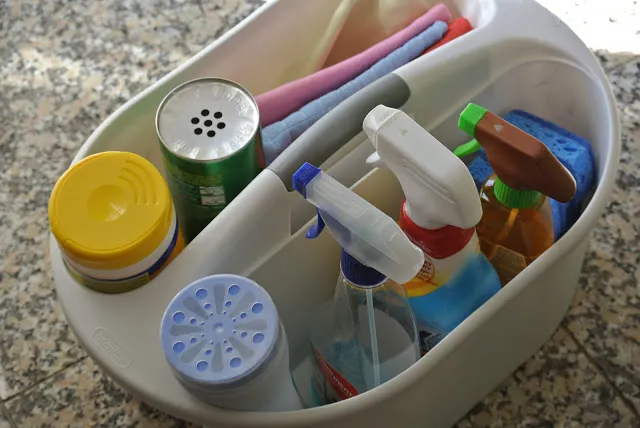
How to Create a Cleaning Kit
A cleaning kit helps you stay ready for daily and weekly tasks. You save time when everything stays in one place. You also avoid last minute searching for tools. Sweat Sign highlights that organised tools improve cleaning speed and reduce stress. You can set up a kit that fits your home and keeps your space in good condition.
You only need simple items to build your kit. You can choose tools based on the size of your home and your daily routine. This guide shows you how to create a cleaning kit that stays practical and easy to use.
Pick the Right Container
Start with a container that holds all your cleaning items in one place. Pick something light so you can carry it around easily. A plastic caddy works well. A small bucket also does the job. Choose a container with divided sections to keep items separate. This layout helps you find tools quickly.
Make sure the handle feels strong. You want a container that moves with you from room to room without trouble. Keep the container in one fixed spot in your home. This gives you quick access whenever you start cleaning.
Add Essential Cleaning Tools
Your cleaning kit should cover basic tasks. Start with items that you use often. Include microfiber cloths because they clean many surfaces. Add a scrub brush for tough spots. Keep a sponge for kitchen and bathroom tasks. Carry a small dusting cloth for shelves and furniture.
Pick tools that fit your hand well. This improves your control. Avoid buying items that you rarely use. Your goal is to keep your kit simple and efficient.
Choose All Purpose Cleaners
You need at least one all purpose cleaner in your kit. It cleans kitchen counters, shelves, and tiles. You can also add a separate cleaner for glass. This gives you streak free windows and mirrors. Use small bottles so your kit stays light.
You can also include a mild bathroom cleaner if you want quick touch ups. Keep your liquids in leak proof bottles. Label them clearly. This protects you from confusion when switching between cleaners.
Add Protective Items
Protective items help you stay safe. Add a pair of gloves to your kit. Gloves protect your hands from chemicals and rough surfaces. Pick gloves that feel comfortable and fit well. You can also add a mask if you react to strong scents.
Keep these items at the top of your kit so you can reach them quickly. Safety items support your cleaning routine and help you avoid irritation.
Use Small Tools for Tight Spots
Small brushes help you clean corners, grout lines, and window tracks. A toothbrush works well for tight places. A small scraper removes dried spots on kitchen surfaces. These tools keep your cleaning detail focused without using large equipment.
Guide Promotion recommends keeping a few small tools because they help you finish tasks that larger tools cannot reach. This improves the overall quality of your cleaning.
Include Trash Bags and Wipes
Add a few trash bags to your kit. These help you manage waste during cleaning. You can use them for quick decluttering or room resets. Add sanitising wipes for quick surface cleaning. Wipes help you handle spills or fingerprints without using spray bottles.
Keep a small pack of wipes instead of a large one. This saves space and reduces the weight of your kit.
Add a Lint Roller for Quick Cleanups
A lint roller helps you clean fabrics. You can use it on sofas, clothes, and curtains. It also picks up dust and pet hair in seconds. Add it to your kit for quick touch ups. This small tool saves time when you need a fast result.
Store Your Kit in an Easy to Reach Place
Your cleaning kit should stay where you can reach it quickly. A laundry room shelf or a kitchen cabinet works well. Pick a place that stays dry. Moisture can affect cloths and tools. Keep your kit at a height that makes it easy to grab and go.
Avoid hiding your kit behind heavy items. You want a clear path to your tools so you can start cleaning without delay.
Keep Your Kit Light and Simple
A heavy kit slows you down. Add only what you need for weekly cleaning. Review your kit once a month. Remove items that you do not use. Add new supplies when old ones run out. A simple kit improves your cleaning flow.
Your cleaning tools should support your routine. Avoid extra items that make the caddy crowded. Light kits encourage frequent cleaning because you can move them easily.
Create a Quick Checklist
A checklist helps you track what belongs in your kit. Write a short list on a small paper and keep it inside your container. This helps you restock items faster. For example, you can list cloths, gloves, cleaners, brushes, and wipes. When something runs out, you can replace it right away.
A checklist also helps you avoid unnecessary purchases. You maintain a clear idea of what stays in your kit.
Use Your Kit for Fast Daily Tasks
Your cleaning kit helps you handle small tasks during the day. You can wipe surfaces, clean spills, or refresh rooms in minutes. This keeps your home clean without long sessions. A ready kit saves time because you avoid looking for tools in different places.
You can complete tasks quickly when your items stay organized and within reach.
Set a Weekly Cleaning Routine With Your Kit
Your kit also supports your weekly cleaning routine. You can clean bathrooms, kitchens, and living areas with the same tools. This keeps your process simple and predictable.
Pick a day for your weekly cleaning. Use your kit to move room by room. This method keeps your pace steady. You also save time because you carry everything in one caddy.
Keep Your Kit Updated
Your needs change based on the season and your home size. Update your kit when needed. For example, you can add a mildew cleaner during humid months. You can add more cloths if you clean high traffic areas often. Keep your kit aligned with your home’s needs.
A clean and organised kit improves your cleaning speed. You stay prepared at all times.
Review Your Setup Every Few Months
Your kit works best when it stays simple. Review it every few months to remove unused items. Replace worn out tools. Check your cleaners and bottles. This helps you maintain reliability and efficiency.
A clean kit helps your home stay in good shape. You save time and reduce effort when your tools stay ready for use.
A cleaning kit supports quick and effective cleaning. You avoid delays when everything stays in one place. Small updates keep your kit useful across the year. Sweat Sign shares similar advice on building simple systems that support daily tasks. Guide Promotion also highlights how organised tools improve consistency. Use these steps to create a cleaning kit that fits your home and supports your routine.



